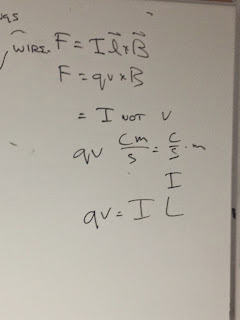

Today we began focusing on a new topic, the second portion of the electromagnetic field, magnetism.
 |
| A magnet pin controlling a compass |
We first started class by Prof Mason demonstrating just what a magnetic field is by having a magnetized pin around the compass and moving the magnetic pin. We notice that the north side is following the magnetic pin
 |
| A discovery of how magnets work |
We also see that if you cut a magnet in half, the ends of those sides become south and north respectively, meaning that it is impossible to have a single north/south side, otherwise known as a magnetic mono-pole
A Maxwell Equation, the integral of B (magnetic field) dA = 0 shows that there is no such thing as a magnetic monopole
 |
| Magnetic Flux |
 |
| Experimentation on exertion of electric charge |
We then go over to see whether or not we can exert force on electrical charges that are moving by using a magnet, and the electron beam of an oscilloscope.
 |
| More on the experimentation |
We find out that once we move the magnet closer to the oscilloscope electron beam, the beam moves over to the left, showing us that the magnetic moves perpendicular to the beam, and therefore the magnetic force is both perpendicular to the direction of the magnetic flux and the moving charge
 |
| Equation proving what we saw |
 |
| The right-hand rule |
We then learned about the right-hand rule, and how important it is to understand how it works so that we can get an idea of where the Force and the Magnetic Field's direction is going
 |
| Back-stepping |
Learning about the right-hand rule, we can go back to what we saw from the electron beam, and figure out where the force is pointing, which in this case, the force is pointing into the board
The next following picture are class examples in which we focused on learning and understanding more about the right hand rule
 |
| Example 1 |
 |
| Example 2 |
 |
| Deriving radius in magnetism |
By using what we know about magnetic force, within a circular region, we are able to then derive an equation for the radius of said region
The next few photos cover over the idea of rotation, primarily omega (angular velocity) and an example problem with it


 |
| Electric field on a current carrying wire |
We then studied the magnetic force of a current carrying wire understand the nature of a non-magnetic wire placed in a permanent magne
 |
| Deriving another formula for magnetic field |
We learned from the experimentation that there is indeed a magnetic force of the wire when the wire starts carrying current, and both the length and the current are perpendicular to the magnetic field, which gives us a second equation for magnetic force = ILxB, where I is the current, L is the length, and B is the magnetic field
 |
| Add caption |
To get more of a grasp of how the magnetic field and force works, we were given a system where the magnetic field's direction is known, and asked where the magnetic force is point at each instance
We learned that the magnetic force only point when the magnetic field is parallel to the points shown, therefore only B and D are shown to have a force, pointing inside and outside respectively.
No comments:
Post a Comment